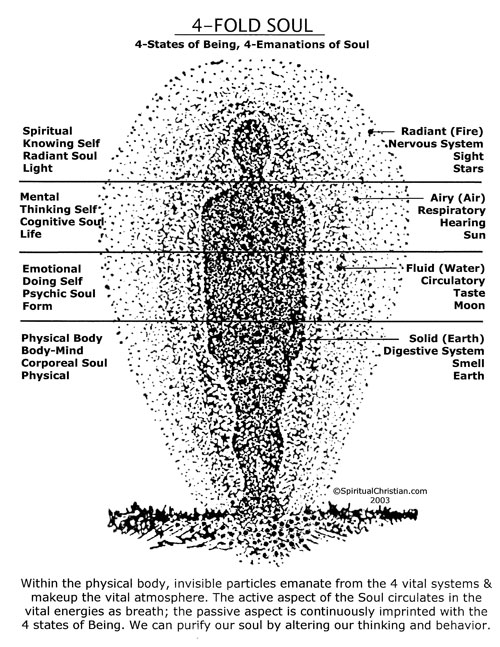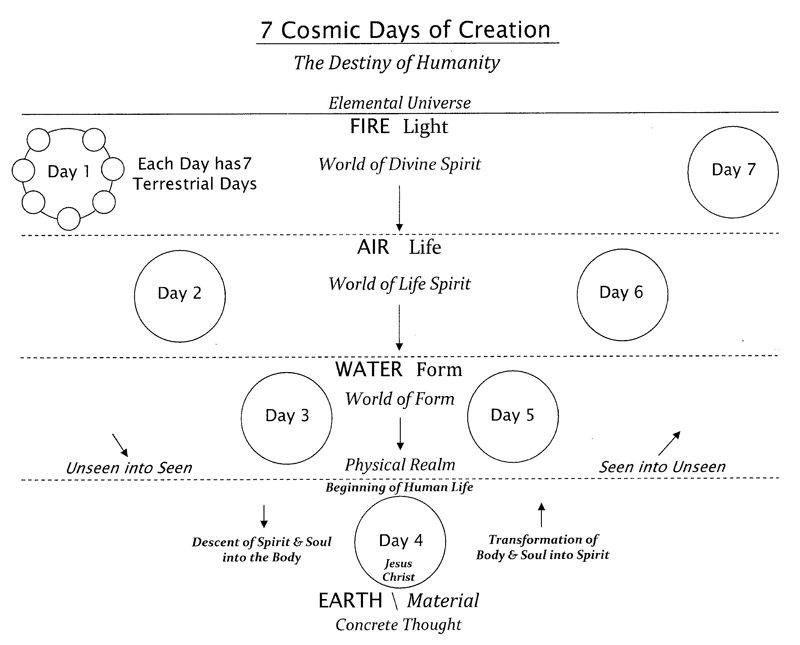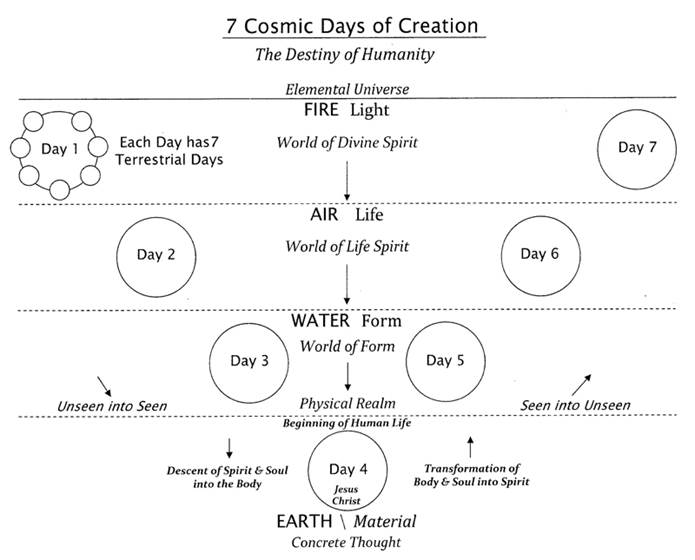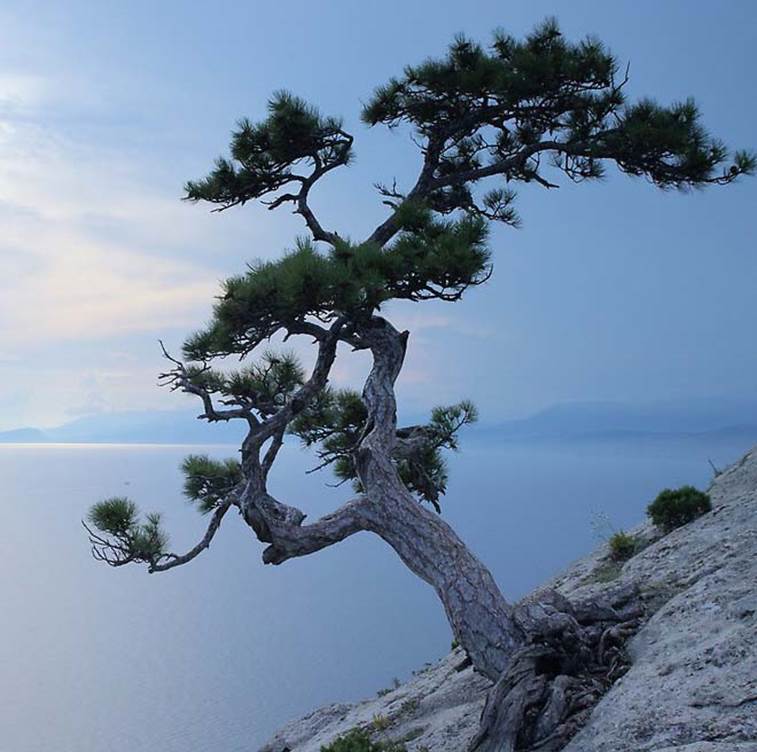PERCEPTION
The Evolution of Consciousness
For each of us, the journey through life has been a journey through consciousness, primarily because everything we experience through the nervous system and senses of the physical body is consciousness. We don’t measure our life experiences based on consciousness development because, in most cases, people don’t really understand consciousness; we are measured as individuals based on: how we present ourselves, our social status, our education, our maturity and experience.
However, in this journey of life, each of our experiences becomes stored memories, and these past memories are the content of our life experience. The totality of this content forms our concept of who we are; the content of our experience is consciousness. So the conscious awareness of who we think we are is actually an awareness of who we were, since we are basing the self-concept on past experiences. The historical collection of past experiences is NOT the true identity of one’s being and soul.
This means almost everyone in the world, in reality, does not know who they really are, but instead, they only know who they were based on a concept comprised of experiences both: good and bad, painful and pleasant, joyful and frightening, harmful and beneficial, hopeful and disappointing, etc. The self-concept is the platform from which we engage the world and the stability of this platform is determined by what kind of experiences we have had; how well we process these experiences determines what kind of experiences we are currently having.
This knowledge about the functioning of consciousness in the ego-persona makes it clear that the self-concept is fluid and changeable; on a daily basis our self-concept changes as new experiences are encountered. The ego-personality is a very significant part of who we think we are and like all things in the universe, it is comprised of consciousness; it follows the same pattern described above of identifying itself from the contents of its past experiences, so it does not know who it is either, but only what it has experienced.
The many experiences it has been through by the time it reaches adulthood have established a significant framework of: likes/dislikes, want/don’t want/, happy/sad, acceptable/unacceptable, plus an array of fears, anxieties and insecurities. It is through this filter that the ego-persona experiences life and people, so all events and individuals are evaluated based on the content of one’s life events. Since every new experience is compared to and judged from a similar past experience, it is impossible for the ego to be in the present moment.
This framework of content has armored or conditioned the individual so he or she is able to engage and function in the fearful and unknown aspects of the world, but this protective framework makes it very difficult to know or to be who we really are or to experience present-time reality. Not only does this armoring filter out those parts of the world we are reluctant to experience, but it also separates us from our divine Self.
Today, our experience of life is unique and different from any human experience in history because consciousness evolves and develops into greater awareness every day, individually and collectively. Since we are one with consciousness, at some point in time, we will leave behind the ego and the bodily concept of self we cling to today; in the future, we will be our true Self. In order to understand where we are today and where we are going, we need to understand the more primitive structures of consciousness humanity has passed through and how we humans experience these same structures of consciousness in the early developmental periods of our individual life.
Evolution of Consciousness & the Body
From inception, the soul and radiant body of the individual, which carries the matrix of the human body, draws to itself the matter of the elemental world to form our bodies. The 4-fold elemental universe is composed of the same matter as the bodies of humanity; our elemental bodies and the physical matter of the earth are identical and both are subject to the same universal laws. On this level of earth, our bodies and elemental matter are linked, but it is consciousness which determines the path of development; in other words, first comes the light, then the eye to see it.
Who we think we are and the daily changes occurring in our bodies, are ALL transformations of consciousness; with each new altered conscious state, the particles of elemental matter are rearranged accordingly, for sickness, health or developmental progress. The body is not what defines us as an individual being; instead, it is conscious growth which defines the changing body. Conscious Intelligence and our soul, which represents the totality of our experiences, imprints and expresses itself onto, into, and through the elemental form of the body giving each person a unique image, characteristics, and presence which correspond to the individual’s soul.

The transformative changes which have occurred historically in the human experience are the results of consciousness advancing through different dimensions of perception referred to as structures of consciousness (See: Ever Present Origin by J. Gebser); they are Archaic, Magical, Mythical, and Mental states of consciousness. As the collective consciousness of humanity advances, the physical form, the brain and nervous system, the 4 senses, and the vital organs are genetically altered to correspond to these advancements. Consequently, since the beginning of time, the human life experience has been a constant ebb and flow of advancing consciousness for the development and refinement of the physical body.
The chronological evidence of how early humanity experienced the world in the different structures of consciousness is found in the gradual awakening of depth perception in the paintings produced by early humans, beginning with the Paleolithic cave paintings of France all the way through to the Renaissance period. Early humans experienced these fluid states of consciousness as they transitioned from one-dimensional reality to three-dimensional perception. The paintings below are evidence of how human perception changes as we move forward in time; it is an historical record of how human perception changes the way in which we see and experience the world.
This revelation of evolving consciousness in humanity is amazing, but it is even more amazing when viewed from the perspective of the evolving Creation, in particular, the evolving 7 Days of Creation (a companion topic of evolving consciousness). The concept of the 7 Days of Creation comes from the acclaimed book The Rosicrucian Cosmo-Conception by Max Heindel. My research and contemplation over several decades have confirmed for me the reality that creation is in a state of becoming that which God intended for it to be. In the realm of the physical universe, the Creation spoken of in Genesis is actually the 4th day of the creation describing humanities descent into physical matter.
Most of the ancient manuscripts on the Creation mythologies from the Gnostic, Taoist, Hindu, and Buddhist traditions have assigned various time-frames to the early formative periods of the universe, but for our discussion, “eons of time” is sufficient. The details of time are not important because the first 3 days of Creation were a dark, formative, and unconscious period for humanity, much like being in the cosmic womb. These formative stages of elemental Creation are the subject of many Creation mythologies which focus primarily on the origin of humankind and the universe.
These mythologies offer some wonderful symbolism to describe the early periods of the universe and the formation of our bodies which help us to recognize the nature and order of Creation. It helps to remember the saying, “There is some truth in myth and some myth in truth.”
The diagram below is a simplified version of the 7 Days in order to understand where we are in the evolution of humanity in creation and the importance of Jesus Christ. Since humanity’s “fall” into the elemental world of physical matter on the fourth day, humanity has been in a constant transition through stages of consciousness and the development of our human physical form. In the second diagram below, are represented 7 cycles which occur in a day of creation; a “micro 7 days of creation.”
The diagram below illustrates humanity’s descent through the first three days in the cosmic womb into the fourth day and how at the lowest point of our descent, God, the Father sent Jesus Christ into the world to awaken humanity and to reveal to them the fullness of our spiritual potential through the teachings of Christ and the miracle of His death, resurrection, and ascension. Jesus Christ, by His sacrifice, took on the collective sins of humanity to stop the descent of our spirit, body and soul into elemental matter and begin the ascent of our body and soul into the spirit.

SpiritualChristian.com

Structures of Consciousness
As stated above, all structures of consciousness are present in humanity in latent or acute form. This means humans in primitive tribes around the world today still perceive their environment as did their pre-historic counterparts. Tribal people, past and present, living in a primitive and isolated environment experience archaic consciousness as a one-dimensional reality meaning that it was/is experienced as a background in which individual objects were/are indistinguishable and not recognized.
There was vague evidence of depth perception in cave paintings, but it was not consciously recognized by the people in this period. Technically speaking, archaic consciousness (the ever-present origin) is “mass” consciousness as it has not yet developed into structured or dimensional consciousness, so animals, plants and elemental forces were indistinguishable one from another. A complete discussion on how the structures of consciousness are related to early childhood developmental stages of humans; see the paper: Recapitulation.
Most paintings of this period did not depict interaction between the images, although one of the few is included which has both animals and humans (images below). These Paleolithic cave paintings are dated as being 30-35 thousand years old. More of these paintings can be seen in Bing/images of Chauvet and Lascaux cave paintings. This is the rudimentary beginning of perception, or what could be called “on-ness” in which the images of life are perceived like flat images on a screen or canvas; even though they have height, breadth and thickness, these characteristics were not consciously recognized.
Today, “on-ness mentality” is still active in many primitive people’s consciousness as they see the world primarily as being filled with animated objects; this includes people. This means their level of consciousness objectifies everything and everyone so as to determine how the objects relate to their individual life experience. Consequently, their interaction with the world is relatively rational, impersonal, and disagreements produce outbreaks of raw emotion. Regardless of whether a person has this type of low mentality, most people today perceive the world through “on-ness” meaning all objects are recognized by their exterior, and all objects reside “on” the surface of the planet. This perception denotes that archaic consciousness is still existent in the world today. Archaic Structure; On-ness; Element: Earth; Consciousness experienced by an infant.


The paintings below show evidence of greater awareness emerging regarding the details of the background and the interaction between people, but the view still appears as a flat backdrop to the painter’s eye. Below are paintings by Coppo di Marcovaldo (1250)
Christ in Majesty and Last Judgment notice the flat-surfaced, one-dimensional effect of the painting. This is not impressionistic, but realism; they are painting as their mind perceives life. Obviously, there was depth visible in their environment, but it was simlpy that the people of the time period were not conscious of it; it was a non-issue.
This is one-dimensional perception, but the subjects in the paintings are conveying a meaningful and intangible energy which they are expressing. This perception is still “on-ness” but what is emerging in this period is the subjects are recognized and so are the feelings and sensibilities emanating from within them; this is the rudimentary expression of “in-ness.” Without in-ness there would be no on-ness; in-ness makes objects appear solid. These dimensional perspectives are the qualities and dimensional relationships of the matter in one-dimensional consciousness. Magical Structure; On-ness with emerging In-ness; Element: Earth and Water; Consciousness experienced by young children.


Next, 100 years later, see the painting Annunciation to the Shepards by T. Gaddi and Courtly Women Listen to Music by Orcagna (1350); these are still flat-surfaced, but the depth effect is much more noticeable. This is the perception of “in-ness” as the subjects are present, but they are now secondary to the feelings and sensibilities felt within the individuals in the scenes. These scenes express that in this period of time, people were beginning to awaken and to be conscious of feelings, their own and others, on a social and spiritual level. In humanity, “in-ness” indicates the awakening of the psychic nature represented by water. Symbolically, fluids in a two-dimensional world are contained IN something whether it is blood in the veins or sap in the tree.
In present time terminology, the lower psychic consciousness is emotional as this is also the realm of the shadow, the personal unconscious; whereas, the higher psychic energies express common-sense feelings and empathy. The mentality expressed from the lower psychic is dark, volatile and/or irrational emotions; whereas, the sensibilities expressed from the higher psychic are refined, civilized and rational sentiment. Some people who are stuck in “on-ness” have difficulty clearly expressing their emotions. These thumbnail descriptions are only meant to convey, in general terms, the conscious energy characteristic of these levels of awareness. Mythical Structure; In-ness; Element: Water; Consciousness experienced by adolescents in the developmental stages.


Next, another 100 years, see St. Jerome in his Study by Antonello da Messina and Agony in the Garden by Mantegna (1450) and notice the significant difference in the depth perception revealed in these paintings as well as proportion and realism. This is the beginning perception of “through-ness” in which the subjects, their feelings or activity, and the 3-dimensional scenery in all its detail are present and interrelated. These are the components which make third-dimensional reality as we know it – that is the seeing, hearing, tasting and smelling or perceiving all of the subjects, surfaces and circumstances of the moment.
Through-ness is continuity and consecutive relationship between objects; it is the expression of the quality of matter which pervades all things. On-ness and in-ness comprise the mass of earthly life, whereas, through-ness relates the various parts of the mass and goes through them. This connection of life, feelings, and mind is the expression of civilized society. Mythical and emerging Mental Structure; In-ness with emerging Through-ness; Element: Water and Air; Consciousness of beginning maturity.


And finally, around 1500 in the Renaissance Period, here are the most famous painters of the time (L to R): Raphael - The Vision of Ezekiel; Da Vinci - Madonna of the Rocks; and Michelangelo - The Last Judgment; respectively. These artists painted what we see today in the third-dimensional mental structure of consciousness. This perception is the maturation of “through-ness” and indicative that humanity is beginning to take control of life.
These paintings express a clear, albeit, symbolic reality in every detail in which we see the anatomy of the bodies in third-dimensional reality with the subjects expressing various feelings based on the particular theme. What is unique in the visionary paintings by Raphael and Michelangelo is their spiritual perspectives are striving to discover and express fourth-dimensional noetic reality or the next structure of consciousness, Christ-consciousness. Mental Structure; Through-ness; Element: Air; Consciousness of mature adult.



This brief overview of the structures of consciousness has been presented so the reader may understand how little we know about the ever-changing and multi-dimensional nature of consciousness. These structures of consciousness consist of the archaic, magical, mythical, mental and the noetic (element: fire/light) with its signature fourth-dimensional characteristic of Presence, meaning that it is everywhere at once and is not obstructed by the other dimensions; this is discussed below.
On-ness, in-ness, through-ness and presence must all work together to create the scenery that surrounds us. On-ness is inert, but in-ness, through-ness and presence are dimensions of matter which are independent of the visible world, yet these active forces work through on-ness to create what we experience as solidity, color, outline, shadow, reflection, and refraction. Hopefully, it has been made clear that these structures of consciousness do not lay dormant in the historical past, but are still present in more or less latent and acute form in each one of us. These states of consciousness also correspond with the Christ Meditation system: on-ness (Stage 1), in-ness (Stage 2), through-ness (Stage 3), and Presence (Stage 4).
The importance of these third-dimensional structures should not be underestimated for in each new life we live, we will pass through these structures repeatedly, beginning with the archaic, in our development toward adulthood. We will come to rest at the point of consciousness to which we have risen in the past life and from this point the forward progress of conscious development once more begins. This repeated cycling is called recapitulation (See link below) and its primary purpose is to embed these states into our consciousness as they are vitally important to the functioning of the instinctual, psychic, mental and spiritual nature of our being.
Thus, in today’s world, people rise or sink to the level of life for which they are fitted, by: the quality of consciousness they have developed; the purity of their souls; the balance of their bodies; and the resilience of their self-determination. The social ascension of those who are most physically fit, mentally adept, morally established and spiritually enlightened should be encouraged. Individuals must find their natural place in the world based on the qualities of their being.
The Noetic Structure of Consciousness – Knowing Presence
Miraculously, what brings the spokes of multi-dimensional consciousness together as in the hub of a wheel is the commonality of the spiritual nature. In the spiritual core of all human beings, differences and distinctions are unknown. The enlightened soul perceives harmony and oneness, not separation and illusion. The awakening of the individual self from the confusion and attachment to the materialistic, fragmentary and illusory worldview of the ego-persona is likely to come only when extreme conditions and adverse circumstances leave no other choice or perhaps the perils of the degeneration of society awakens the sense of urgency. A positive alternative would be to make a conscious decision based on inspiration or even common sense.
Liberating the individual from the snares of modern society is no easy task. To understand the necessity for such a change, and to possess the knowledge for realizing this change are not sufficient. What is required is the courage to unravel, to deconstruct and to voluntarily relinquish the present habits, impulses, and cravings of the ego-personality which keep one attached to the pleasures of the world. The individual cannot be liberated from the world without suffering. He or she is the marble and the sculptor. In order to uncover one’s true nature, the individual must shatter his or her own substance with heavy blows.
It is not that the individual is incapable of personal transformation; it is that the individual lacks the volition to submit to such treatment unless driven by necessity or fear. The conditioning of humanity by modern society glazes the vision and instills apathy toward developing spiritual refinement; the concrete/rational mind deems the spiritual, moral, and creative sensibilities to be irrelevant.
Regardless of the motivating trigger, there must be a temporary separation of the individual from the ego-personality and worldview in order to interrupt the habitual attachments to the physical, sensual realm. The illusion that worldly pleasures can bring lasting comfort, in whatever form, must be acknowledged and renounced before self-consciousness can transition from the third-dimensional material world and ascend to the internal self-realization of fourth-dimensional Noetic (knowing) consciousness.
This is the ever-present realm of consciousness that many will experience in the twinkling of an eye; a realm that transcends time, culture, sickness, pain, hunger, and separation as we will all experience oneness in Christ consciousness. The preparation for such a transition to occur requires that we as individuals must become proficient in the transformation of consciousness through the practices of renunciation, self-discipline, right living, humility through prayer, quiet self-reflection, and/or focused meditation. The sublime experiences that come from developing and living in these exceptional states are scarcely understood.
Those who understand the internal states of consciousness, turn their attention inward to find answers to their questions because they recognize that consciousness itself is the source for the answers. These individuals realize that their consciousness is actually connected to and one with the Universal Consciousness or Divine Presence (See: Stage 4 Meditation). They know how to be receptive to the knowledge inherent in consciousness and how to modify their internal state to receive answers directly through intuition and insight.
These people realize and accept responsibility for their lives, the condition of their conscious state, and for creating the circumstances of their lives. Those who give priority to contemplating the truth and beauty of the sacred over gratification from the mundane will develop inner sensibilities that bring peace, happiness, grace, and insight. When consciousness ascends the highest summits and is illuminated by intuition and creative imagination, it provides impetus for enthusiasm and inspiration toward the supreme goal – the awakening of moral ideals, spiritual sensibilities, and the appreciation of beauty, goodness, and light then truly we will be who we ARE rather than who we were.
Next: Recapitulation
SpiritualChristian.com

*
* *

